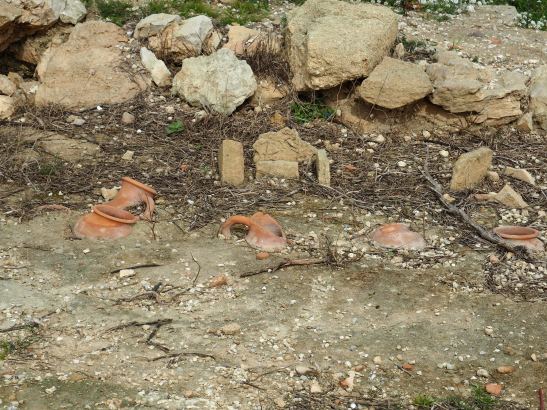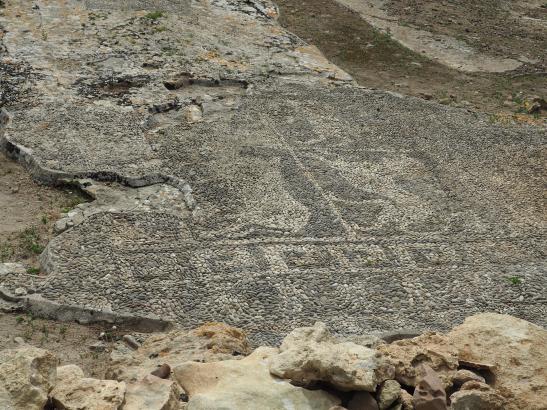The Muddy Archaeologist's Blog
Blog by Gillian Hovell, The Muddy Archaeologist www.muddyarchaeologist.co.uk
Sicily – Land of the Phoenicians
A holiday in Sicily is a time-travelling adventure. So many civilisations have settled here over the millennia.
One of the earliest peoples to berth their ships here were the Phoenicians. They were traders extraordinaire and they sailed, loaded with merchandise from everywhere they stopped, trading and bartering their way to a solid profit. Expensive perfume in little alabastra (perfume jars) could fetch a good price and many Phoenicians would be buried in hefty sarcophagi on which his or her face, arms and toes were the only sculpted features except for the source of their success, the alabastron. Although the Phoenician homeland was Tyre on the shores of modern Lebanon, these sarcophagi can be found as far west as modern Gibraltar.
Although these traders touched so many cultures wherever they landed, they remained relatively untouched themselves. Their religion consistently involved the worship of Tanit whose symbolic emblem resembled a disconcertingly demented Dalek but was really a potent goddess of love and fertility and of war too. She appears on tombstones and on shop floors. She would travel far – even reaching Catterick in northern Britain.
But there were many other gods. The sun god, Baal (famous from the Old Testament’s Canaanites’ worship) and moon god Astarte were the greatest amongst the throng. The Phoenician infant graveyards (each a Tophet) spawned tales of child sacrifice – the first born sons – as babes lay in the hands of the statue of the divine and were, the stories said, burned alive, their faces covered by a grinning mask. Yet all infants were cremated here, so the archaeologists’ debate continues today; how much was sacrifice and how much burial rites? The infant necropolis are uncomfortable places though, even today.

Tophet, Motya, Muddy Archaeologist
Adults were cremated too, and placed in urns in a separate necropolis. You can experience these on the wonderful, tiny, island of Motya, a short boat ride from the mainland of Sicily.
Here you can walk around the impressive walls from the 500s BC, and be daunted by the towers and by the gateways with their eroded wheel tracks that led out to the shallow underwater ford, a paved roadway to the island (so that nothing could stop the flow of trade to the locals).
That trade would include cedars from Lebanon, gold, glass, jugs and amphorae full of goodies. Lamps bear witness to long days, and an industrial area was littered with weaving and pottery finds. But it was the purple fabrics, dyed with the extracts from the murex sea shell, that made the Phoenicians most famous. Indeed, Phoenician was the name given by the Romans and meant ‘the purple people’. They would call the later remnants of the Phoenicians, driven by Alexander the Great from Tyre to Carthage in Northern Spain, not just Carthaginians, but ‘Punic’. What the Phoenicians called themselves, we simply don’t know.
We do know that the Phoenicians loved settling on islands; they sought no conflict with locals, just a home on an unloved liminal patch of land close enough to become a vital trading emporium. If an island had two harbours on different sides, all the better; then you could sail, no matter which way the wind was blowing; a distinct advantage in a time that remembered the awful horror of the legend of Iphigenia’s sacrifice by King Agamemnon so that the weeks of hindering easterly winds would turn to take the Greeks to battle at Troy.
Of course, the Phoenicians hadn’t arrived into a vacuum on Sicily. There were already several cultures settled here – the Elymians, the Sicels and the Sicani had arrived in the time of the Fall of Troy in c.1,200 BC. Since then, cultures in the Eastern Mediterranean had descended into a dark time of deserted cities and subsistence farming.
But from c.900 BC, the populations had grown and by the 700s BC towns began to flourish so much that the Greeks would send their own now-crowded citizens packing from the limited fertile lands of stony Greece, to sail the seas and found new settlements, daughter towns of the mother city (or metropolis: metr- being ‘mother’ and polis a Greek city-state/town). Greeks and Phoenicians would be uneasy neighbours, yet both benefitting from each other’s trading & supply opportunities.
Such business prompted the Phoenicians to develop their greatest legacy: while other civilisations wrote in hieroglyphics or cuneiform, they invented the alphabet; symbols represented sounds not ideas. Undoubtedly prompted by their record-keeping needs, inscriptions to the gods are the most frequent survivor of their writings. Literature it wasn’t. That would grow from the Greeks’ adoption of the squiggles for letters (their first letters being alpha, beta … hence the ‘alphabet’) when Homer preserved the old, old tales in his Iliad and Odyssey in c.750 BC.
Contact between the cultures is evidenced by the astonishing Youth of Motya. Created by Greeks early in the 400s BC, it contrasts dramatically with the Charioteer of Delphi with its severe style; the flowing pleated but transparent tunic, the vibrant cheeky pose … so many questions but few answers.
Egyptian influences abound, and Greek products clutter the Phoenician world in Sicily. But it was a Greek, Dionysius, tyrant of Syracuse, who would yearn to remove the Phoenicians, and would destroy the island community in 397 BC.
Visit Motya, and you walk in the footsteps of the first Phoenicians to land here in the 700s BC, stroll through the centuries to the late 300s BC when the Carthaginians resettled the island; a grand house boasted river pebble mosaics of a lion attacking a bull and a griffin launching itself at a horse.

mosaics Motya Muddy Archaeologist
The Phoenicians, mysterious but energetic, busy, industrial and commercial, but religious too. They sailed the Mediterranean and connected peoples and cultures. They may not have had a conventional empire, but they were quite remarkable.
The Greeks also spread around the Med, as Aristotle said, ‘like frogs around a pond’. Their culture was very different though …




























Fantastic article Gillian, thank you. Really well-researched, and you’ve captured the excitement of Sicily’s Phoenician Archaeology.
LikeLike
Thank you, Mark. A little on the Greeks in Sicily and, later, the Romans will follow. Just a couple of tasters of a remarkable island …
LikeLiked by 1 person
Pingback: Sicily: A Jewel of the Roman Empire | The Muddy Archaeologist's Blog
Hi – what’s the second inscription?
LikeLike